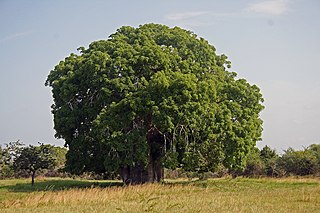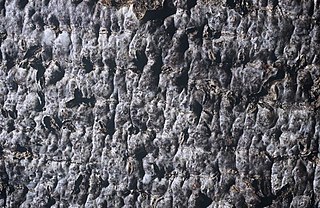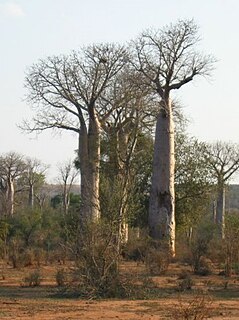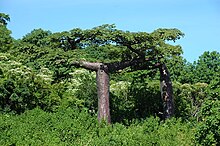
Adansonia is a genus made up of eight species of medium to large deciduous trees known as baobabs. They are placed in the Malvaceae family, subfamily Bombacoideae. They are native to Madagascar, mainland Africa, and Australia. The trees have also been introduced to other regions such as Asia. The generic name honours Michel Adanson, the French naturalist and explorer who described Adansonia digitata. The baobab is also known as the "upside down tree", a name that originates from several myths. They are among the most long-lived of vascular plants and have large flowers that are reproductive for a maximum of 15 hours. The flowers open around dusk, opening so quickly that movement can be detected by the naked eye, and are faded by the next morning. The fruits are large, oval to round and berry-like and hold kidney-shaped seeds in a dry, pulpy matrix.

Adansonia gregorii, commonly known as the boab and also known by a number of other names, is a tree in the family Malvaceae, endemic to the northern regions of Western Australia and the Northern Territory of Australia.

Alluaudia ascendens is a species of Alluaudia endemic to Madagascar. It can reach 15 m in height. Its local name is fantsiolotse.

Adansonia digitata, the African baobab, is the most widespread tree species of the genus Adansonia, the baobabs, and is native to the African continent and the southern Arabian Peninsula. These are long-lived pachycauls; radiocarbon dating has shown some individuals to be over 2,000 years old. They are typically found in dry, hot savannas of sub-Saharan Africa, where they dominate the landscape and reveal the presence of a watercourse from afar. They have traditionally been valued as sources of food, water, health remedies or places of shelter and are a key food source for many animals. They are steeped in legend and superstition. In recent years, many of the largest, oldest trees have died, possibly due to climate change. Common names for the baobab include monkey-bread tree, upside-down tree, and cream of tartar tree.

The Madagascar dry deciduous forests represent a tropical dry forest ecoregion situated in the western and northern part of Madagascar. The area has high numbers of endemic plant and animal species but has suffered large-scale clearance for agriculture. They are among the world's richest and most distinctive dry forests and included in the Global 200 ecoregions by the World Wide Fund. The area is also home to distinctive limestone karst formations known as tsingy, including the World Heritage Site of Bemaraha.

Dekeyser's nectar bat is a bat species from South America. It is found in Brazil and Bolivia.

The Anjajavy's Protected Area is located on a peninsula of the town of Antonibe, in the district of Analalava and in the north-west region of Madagascar. It is part of the Sofia region of the independent province of Mahajanga and its position is between 47°13’ at 44°22’ of longitude east and 14°58 at 15°07’ of latitude south..

Adansonia madagascariensis or Madagascar baobab is a small to large deciduous tree in the family Malvaceae. It is one of six species of baobab endemic to Madagascar, where it occurs in the Madagascar dry deciduous forests.

Adansonia rubrostipa, commonly known as fony baobab, is a deciduous tree in the Malvaceae family. Of eight species of baobab currently recognized, six are indigenous to Madagascar, including fony baobab. It is endemic to western Madagascar, found in Baie de Baly National Park, south. It is associated with well-drained soils and is found in dry and spiny forests. It occurs in the following protected areas: Amoron'i Onilahy, Baie de Baly, Menabe Antimena, Mikea, Namoroka, Ranobe PK 32, Tsimanampesotse, Tsimembo Manambolomaty, Tsinjoriake.

Adansonia grandidieri is the biggest and most famous of Madagascar's six species of baobabs. It is sometimes known as Grandidier's baobab or giant baobab. In French it is called Baobab malgache. The local name is renala or reniala. This tree is endemic to the island of Madagascar, where it is an endangered species threatened by the encroachment of agricultural land. This is the tree found at the Avenue of the Baobabs.

Adansonia perrieri, or Perrier's baobab, is a critically endangered species of deciduous tree, in the genus Adansonia. This species is endemic to northern Madagascar. It has been documented in only 10 locations, including Ankarana, Ampasindava, Loky Manambato and Montagne d'Ambre protected areas. Most populations, however, are outside of protected areas. Each location has few individuals. With an estimated population of fewer than 250 mature individuals and ongoing habitat decline due to fire and cutting for charcoal and timber or clearing for mining, this species has been assessed by IUCN as Critically Endangered. There are three species of baobab found in northern Madagascar, all sharing the common name "bozy".

Adansonia za is a species of baobab in the genus Adansonia of the family Malvaceae. It was originally named in French as anadzahé. Common names in Malagasy include bojy, boringy, bozy, bozybe, ringy, and za, the last of which gives the plant its specific epithet. Eight Adansonia species are recognized, with six endemic to Madagascar. Adansonia za is the most widespread of the Madagascar endemics.

The Montagne des Français Reserve is a protected area consisting principally of dry deciduous forest in northern Madagascar. It is part of the larger Ramena protected area complex which also includes Orangea Reserve and the Ambodivahibe Marine Reserve. These three protected areas are currently being created and will be designated in 2008.

The Madagascan fruit bat is a species of bat in the family Pteropodidae. It is endemic to Madagascar and is listed as "Vulnerable" by the IUCN because it is hunted as bushmeat.

The Madagascan flying fox, Madagascar flying-fox, or Madagascar fruit bat is a species of megabat in the genus Pteropus. It is endemic to Madagascar. Its natural habitats are diverse, and include moist lowland forests, dry forests, succulent woodlands, and spiny thickets, and mangroves. It eats figs and other fruits, flowers, and leaves. It is threatened by habitat loss.

Xanthopan is a monotypic genus of sphinx moth, with Xanthopan morganii, commonly called Morgan's sphinx moth, as its sole species. It is a very large sphinx moth from Southern Africa and Madagascar. Little is known about its biology, though the adults have been found to visit orchids and are one of the main pollinators of several of the Madagascar endemic baobab (Adansonia) species, including the critically endangered Adansonia perrieri or Perrier's baobab.

Pachycereus pecten-aboriginum is a columnar cactus plant native to Mexico. They can grow up to 15 m (49 ft) high. The trunk of this species is 1.2 to 5.0 m tall and the fruits are large and burr-like. The specific name, pecten-aboriginum, is from the Latin, and means "native combs". It was inspired by the use of the fruits as hair combs.

Ceiba chodatii, the floss silk tree, is a species of deciduous tree native to the tropical and subtropical forests of South America. It has a bottle-shaped swollen trunk in which water is stored for the dry season and is known locally as palo borracho.

Kirindy Forest or Kirindy Private Reserve is a private park situated in western Madagascar, More precisely, the reserve is situated 50 km northeast of the town of Morondava. The Forest goes through two apparent seasons throughout the year, the dry season from March to December and the rainy season from December to March.6. The forest is home to a wide variety of both Fauna and Flora. Ranging from Lemurs to geckos. Many species of trees are also growing in the forest with a wide variety of endemic trees. The forest was earlier operated based on an experimental sustainable timber harvesting scheme, which has not left indelible scars on the region. It is said in Malagasy cultures that the forest was named Kirindy because Kirindy means in malagasy "dense forest with wild animals". As it is located in the northern area of the Kirindy Mitea National Park, the forest is also known as "Kirindy Nord", meaning northern Kirindy. Before being renamed Kirindy, the forest was called the Swiss people's forest, "la foret des Suisses" as a Swiss company owns the piece of land.
Mediusella bernieri is a plant in the family Sarcolaenaceae. It is endemic to Madagascar.



















